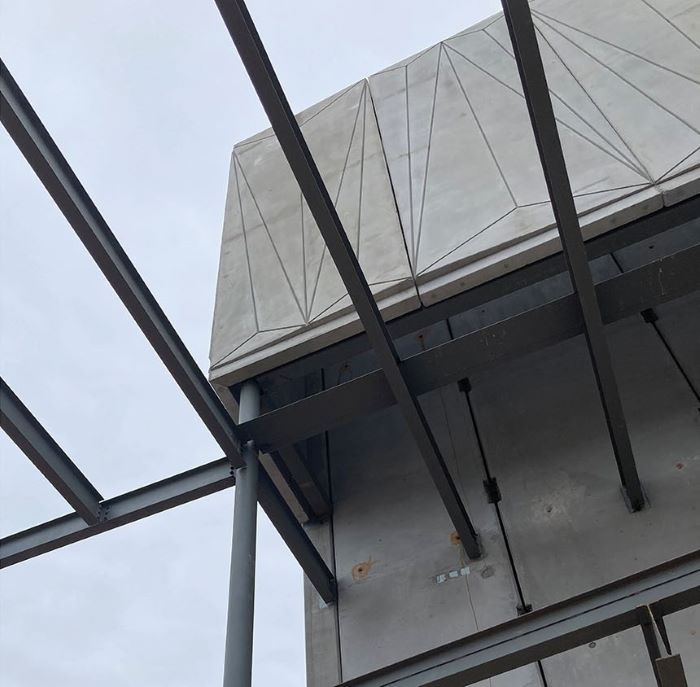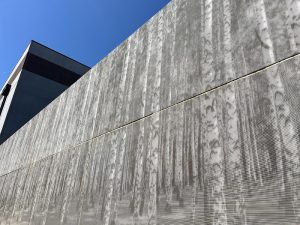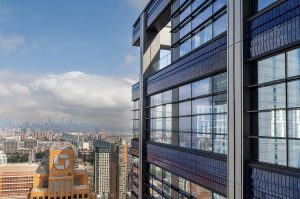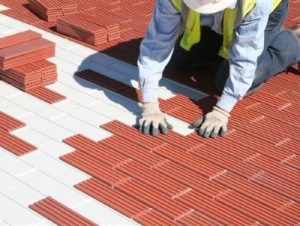
Form liners in the precast, tilt-up, and/or cast-in-place construction industries are essentially molds, typically made of rubber or plastic, that are used to create designs, textures, and patterns on concrete surfaces. The molds are attached to the inside of form systems to imprint desired designs onto newly poured concrete. After the concrete sets, the forms are stripped away, leaving behind the aesthetically beautiful, textured surface beneath.
According to The American Concrete Institute (ACI), form liners create “concrete that will be permanently exposed to view and therefore requires special care in selection of the concrete materials, forming, placing, and finishing to obtain the desired architectural appearance.” In essence, choosing the right form liner for your project can be more complicated than you think, considering that new materials and techniques are being introduced all the time, allowing us to create form liners with more intricate patterns on the concrete surface – realistic rock patterns, detailed graphics, and even photographs.



Evansville Wastewater Treatment Plant, Evansville, IN | Rockefeller Wildlife Refuge, Grand Chenier, LA | QTS, Atlanta, GA
The most basic thing to ask yourself when considering form liners is how many times you want to reuse them. Some materials can be reused around 100 times, while others are intended for only a single use. Prices will vary according to this simple difference. Before we get into some other considerations, let’s talk about the types of form liners.
Types of Form Liners: Elastomeric Rubber (Urethane) vs. Plastic
Elastomeric Rubber (Urethane) Form Liners
An elastomer is a natural or synthetic polymer having elastic properties, meaning that it is stretchable from a point within itself in all directions. Therefore, Elastomeric Rubber Form Liners, by their inherent nature, are indeed stretchable and can create almost any surface texture imaginable, making them ideal for custom projects with intricate detail. While they can be weighty at an average of 6 lbs. per square foot, they are long-lasting (100 or more possible uses). Another advantage that urethane has over other materials is that it can handle pattern surface depth reliefs of up to 5 inches. The cost varies from $14 per square foot to up to $75 per square foot, on average, depending on the relief depth, detail, and the cost of rubber.*



One Willoughby Square, Brooklyn, NY
Plastic Form Liners
Plastic form liners are made from a vacuforming process for single use or up to 15 uses, depending on how thick the plastic is and what type of plastic used. Plastic form liners are flexible, not stretchable. While they are available in a wide variety of patterns, they are, therefore, best suited for projects with less intricate detail, such as ribbed patterns, and a surface depth relief of no more than one inch, which makes them also ideal for cast-in thin bricks on tilt-up job sites. They are lightweight and easy to handle at an average of 0.4 lbs. per square feet. The cost is $1.50 to $7.00 per square foot, depending on the type of plastic used and the depth of relief.*



Liberty at Middlesex, Harrisburg, PA; Versa-Brix® S
How to Choose and Use Form Liners Efficiently and Effectively
- Acknowledge aesthetic needs or desires. It is vital to capture the unique aspects of a project’s design by considering historical, matching, symbolic, or inspirational elements.
- Think about why you are using form liners. It is important to know why you are using them. This can help decide what kind of form liner will be used and how it will be made.
- Choose the right material. Different materials have different strengths and weaknesses, so it’s important to choose the right material for the project. For instance, some materials might last longer or be more flexible, while other might be cheaper.
- Plan form liners to the type of construction. Along with choosing the right material, it is important to understand that some types of construction, like tilt-up, CIP, and Precast, will use only single-use form liners.
- Think about the size and shape of the form liner. The size and shape of the form liner will affect how much material is needed and how easy it is to put in place. When choosing a form liner, it’s important to think about these things.
- Plan for maintenance. Over time form liners may need to be cleaned or repaired. When choosing a form liner, it’s important to think about the maintenance needs and make sure you have the resources you need.
- Work with a trusted supplier. The key to a successful project is to find a reliable and experience form liner supplier. A supplier with a lot of experience can help with the design, choice, and installation of the form liner, as well as give valuable advice and tips.
- Plan for the right installation. For a form liner project to work, the installation has to be done right. It’s important to plan ahead for a proper installation and make sure you have all the tools you need.
Ask the Expert – Marshall Walters, CEO – Architectural Polymers, LLC
Ultimately and in an industrial sense, choosing a form liner (and accessories) for a concrete structure is like an artist choosing the subject matter for a painting.
“As we have seen in the many genres of paint on canvas or statuary, placing textured art on vertical cementitious surfaces considers many factors. Amongst the many, light, viewing distance, and historical/indigenous are the most common.”
Separating masterpiece from mediocre, to fully realize the capabilities of concrete art means having an in-depth knowledge of the materials you use. Being informed is a distinct advantage. Asking the form liner manufacturing expert is a great start, as they have experience with their art capabilities as well as the concrete capabilities learned from their customer experience.
Working with your form liner team will develop the vision and aid you in employing your art for many to influence. The next “masterpiece” awaits!
See what Architectural Polymers, LLC, can do for you! Check out our comprehensive concrete form liner products.
If you are an architect interested in learning more about form liners or thin brick and terra cotta, please register for one of our AIA accredited courses.